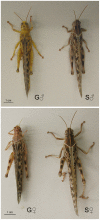Microarray-based transcriptomic analysis of differences between long-term gregarious and solitarious desert locusts
- PMID: 22132225
- PMCID: PMC3223224
- DOI: 10.1371/journal.pone.0028110
Microarray-based transcriptomic analysis of differences between long-term gregarious and solitarious desert locusts
Abstract
Desert locusts (Schistocerca gregaria) show an extreme form of phenotypic plasticity and can transform between a cryptic solitarious phase and a swarming gregarious phase. The two phases differ extensively in behavior, morphology and physiology but very little is known about the molecular basis of these differences. We used our recently generated Expressed Sequence Tag (EST) database derived from S. gregaria central nervous system (CNS) to design oligonucleotide microarrays and compare the expression of thousands of genes in the CNS of long-term gregarious and solitarious adult desert locusts. This identified 214 differentially expressed genes, of which 40% have been annotated to date. These include genes encoding proteins that are associated with CNS development and modeling, sensory perception, stress response and resistance, and fundamental cellular processes. Our microarray analysis has identified genes whose altered expression may enable locusts of either phase to deal with the different challenges they face. Genes for heat shock proteins and proteins which confer protection from infection were upregulated in gregarious locusts, which may allow them to respond to acute physiological challenges. By contrast the longer-lived solitarious locusts appear to be more strongly protected from the slowly accumulating effects of ageing by an upregulation of genes related to anti-oxidant systems, detoxification and anabolic renewal. Gregarious locusts also had a greater abundance of transcripts for proteins involved in sensory processing and in nervous system development and plasticity. Gregarious locusts live in a more complex sensory environment than solitarious locusts and may require a greater turnover of proteins involved in sensory transduction, and possibly greater neuronal plasticity.
Conflict of interest statement
Figures



Similar articles
-
Transcriptome analysis of the desert locust central nervous system: production and annotation of a Schistocerca gregaria EST database.PLoS One. 2011 Mar 21;6(3):e17274. doi: 10.1371/journal.pone.0017274. PLoS One. 2011. PMID: 21445293 Free PMC article.
-
Spatiotemporal receptive field properties of a looming-sensitive neuron in solitarious and gregarious phases of the desert locust.J Neurophysiol. 2010 Feb;103(2):779-92. doi: 10.1152/jn.00855.2009. Epub 2009 Dec 2. J Neurophysiol. 2010. PMID: 19955292 Free PMC article.
-
Increased muscular volume and cuticular specialisations enhance jump velocity in solitarious compared with gregarious desert locusts, Schistocerca gregaria.J Exp Biol. 2016 Mar;219(Pt 5):635-48. doi: 10.1242/jeb.134445. J Exp Biol. 2016. PMID: 26936638
-
Epigenetics and locust life phase transitions.J Exp Biol. 2015 Jan 1;218(Pt 1):88-99. doi: 10.1242/jeb.107078. J Exp Biol. 2015. PMID: 25568455 Review.
-
Molecular mechanisms of phase change in locusts.Annu Rev Entomol. 2014;59:225-44. doi: 10.1146/annurev-ento-011613-162019. Epub 2013 Oct 18. Annu Rev Entomol. 2014. PMID: 24160426 Review.
Cited by
-
Social modulation of ageing: mechanisms, ecology, evolution.Philos Trans R Soc Lond B Biol Sci. 2021 Apr 26;376(1823):20190738. doi: 10.1098/rstb.2019.0738. Epub 2021 Mar 8. Philos Trans R Soc Lond B Biol Sci. 2021. PMID: 33678020 Free PMC article. Review.
-
Contribution of Epigenetic Mechanisms in the Regulation of Environmentally-Induced Polyphenism in Insects.Insects. 2021 Jul 15;12(7):649. doi: 10.3390/insects12070649. Insects. 2021. PMID: 34357309 Free PMC article. Review.
-
Na+-K+-ATPase trafficking induced by heat shock pretreatment correlates with increased resistance to anoxia in locusts.J Neurophysiol. 2014 Aug 15;112(4):814-23. doi: 10.1152/jn.00201.2014. Epub 2014 May 21. J Neurophysiol. 2014. PMID: 24848469 Free PMC article.
-
Genomics: moving behavioural ecology beyond the phenotypic gambit.Anim Behav. 2014 Jun 1;92:263-270. doi: 10.1016/j.anbehav.2014.02.028. Anim Behav. 2014. PMID: 24954950 Free PMC article.
-
Cortical spreading depression-induced preconditioning in the brain.Neural Regen Res. 2016 Nov;11(11):1857-1864. doi: 10.4103/1673-5374.194759. Neural Regen Res. 2016. PMID: 28123433 Free PMC article. Review.
References
-
- Uvarov B. Grasshoppers and Locusts: A handbook of general acridology. Cambridge: Anti-Locust Research Centre (Cambridge University Press); 1966. Phase polymorphism. pp. 332–386.
-
- Uvarov B. Centre for overseas pest research. London: 1977. Grasshoppers and Locusts: A handbook of general acridology.
-
- Pener MP, Yerushalmi Y. The physiology of locust phase polymorphism: an update. J Insect Physiol. 1998;44:365–377. - PubMed
-
- Pener MP, Simpson SJ. Locust phase polyphenism: an update. Advances in Insect Physiology. 2009;36:1–272.
-
- Lester LR, Grach C, Pener MP, Simpson SJ. Stimuli inducing gregarious colouration and behaviour in nymphs of Schistocerca gregaria. J Insect Physiol. 2005;51:737–747. - PubMed
Publication types
MeSH terms
Associated data
- Actions
Grants and funding
- BB/D018587/1/Biotechnology and Biological Sciences Research Council/United Kingdom
- BB/D018854/1/Biotechnology and Biological Sciences Research Council/United Kingdom
- BB/H002510/1/Biotechnology and Biological Sciences Research Council/United Kingdom
- BB/H002537/1/Biotechnology and Biological Sciences Research Council/United Kingdom
LinkOut - more resources
Full Text Sources
Molecular Biology Databases
Research Materials

